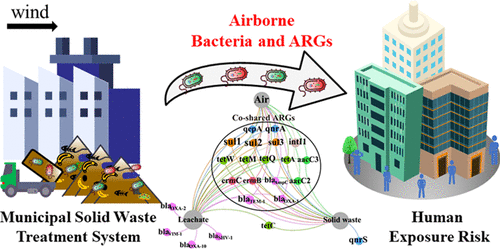当前位置:
X-MOL 学术
›
Environ. Sci. Technol.
›
论文详情
Our official English website, www.x-mol.net, welcomes your
feedback! (Note: you will need to create a separate account there.)
Municipal Solid Waste Treatment System Increases Ambient Airborne Bacteria and Antibiotic Resistance Genes.
Environmental Science & Technology ( IF 10.8 ) Pub Date : 2020-03-25 , DOI: 10.1021/acs.est.9b07641 Linyun Li 1 , Qing Wang 1 , Wenjing Bi 1 , Jie Hou 1 , Yingang Xue 2 , Daqing Mao 3 , Ranjit Das 1 , Yi Luo 1 , Xiangdong Li 4
Environmental Science & Technology ( IF 10.8 ) Pub Date : 2020-03-25 , DOI: 10.1021/acs.est.9b07641 Linyun Li 1 , Qing Wang 1 , Wenjing Bi 1 , Jie Hou 1 , Yingang Xue 2 , Daqing Mao 3 , Ranjit Das 1 , Yi Luo 1 , Xiangdong Li 4
Affiliation

|
Landfill and incineration are the primary disposal practices for municipal solid waste (MSW) and have been considered as the critical reservoir of antibiotic resistance genes (ARGs). However, the possible transmission of ARGs from the municipal solid waste treatment system (MSWT system) to ambient air is still unclear. In this study, we collected inside and ambient air samples (PM10 and PM2.5) and potential source samples (leachate and solid waste) in the MSWT system. The results showed that the MSWT system contributed to the increased ambient airborne bacteria and associated ARGs. Forty-one antibiotic-resistant bacteria (ARB) harboring blaTEM-1 were isolated, and the full-length nucleotide sequences of the blaTEM-1 gene (harbored by identical bacillus) from air (downwind samples) were 100% identical with those in the leachate and solid waste, indicating that the MSWT system was the important source of disperse bacteria and associated ARGs in the ambient air. The daily intake (DI) burden level of ARGs via PM inhalation was comparable with that via ingestion of drinking water but lower than the DI level via ingestion of raw vegetables. The antibiotic-resistant opportunistic pathogen Bacillus cereus was isolated from air, with a relatively high DI level of Bacillus via inhalation (104–106 copies/day) in the MSWT system. This study highlights the key pathway of airborne ARGs to human exposure.
中文翻译:

市政固体废物处理系统增加了空气中的细菌和抗生素耐药性基因。
垃圾掩埋和焚化是城市生活垃圾(MSW)的主要处置方式,被认为是抗生素抗性基因(ARG)的重要储存库。然而,ARGs从城市固体废物处理系统(MSWT系统)到环境空气的可能传播仍不清楚。在这项研究中,我们收集了MSWT系统中的内部和周围空气样本(PM 10和PM 2.5)以及潜在的源样本(渗滤液和固体废物)。结果表明,MSWT系统有助于增加周围的空气传播细菌和相关的ARGs。四十一个抗生素抗性细菌(ARB)窝藏BLA TEM-1中分离,并且的全长核苷酸序列BLA TEM-1空气(顺风样品)中的基因(被相同的芽孢杆菌感染)与渗滤液和固体废物中的基因100%相同,表明MSWT系统是环境空气中细菌和相关ARG分散的重要来源。吸入PM引起的ARGs的每日摄入量(DI)水平与摄入饮用水相当,但低于摄入生蔬菜的DI水平。从空气中分离出具有抗药性的机会性致病性蜡状芽孢杆菌,通过MSWT系统中的吸入(10 4 –10 6拷贝/天),获得相对较高的DI水平的芽孢杆菌。这项研究突出了机载ARGs暴露于人体的关键途径。
更新日期:2020-03-26
中文翻译:

市政固体废物处理系统增加了空气中的细菌和抗生素耐药性基因。
垃圾掩埋和焚化是城市生活垃圾(MSW)的主要处置方式,被认为是抗生素抗性基因(ARG)的重要储存库。然而,ARGs从城市固体废物处理系统(MSWT系统)到环境空气的可能传播仍不清楚。在这项研究中,我们收集了MSWT系统中的内部和周围空气样本(PM 10和PM 2.5)以及潜在的源样本(渗滤液和固体废物)。结果表明,MSWT系统有助于增加周围的空气传播细菌和相关的ARGs。四十一个抗生素抗性细菌(ARB)窝藏BLA TEM-1中分离,并且的全长核苷酸序列BLA TEM-1空气(顺风样品)中的基因(被相同的芽孢杆菌感染)与渗滤液和固体废物中的基因100%相同,表明MSWT系统是环境空气中细菌和相关ARG分散的重要来源。吸入PM引起的ARGs的每日摄入量(DI)水平与摄入饮用水相当,但低于摄入生蔬菜的DI水平。从空气中分离出具有抗药性的机会性致病性蜡状芽孢杆菌,通过MSWT系统中的吸入(10 4 –10 6拷贝/天),获得相对较高的DI水平的芽孢杆菌。这项研究突出了机载ARGs暴露于人体的关键途径。











































 京公网安备 11010802027423号
京公网安备 11010802027423号